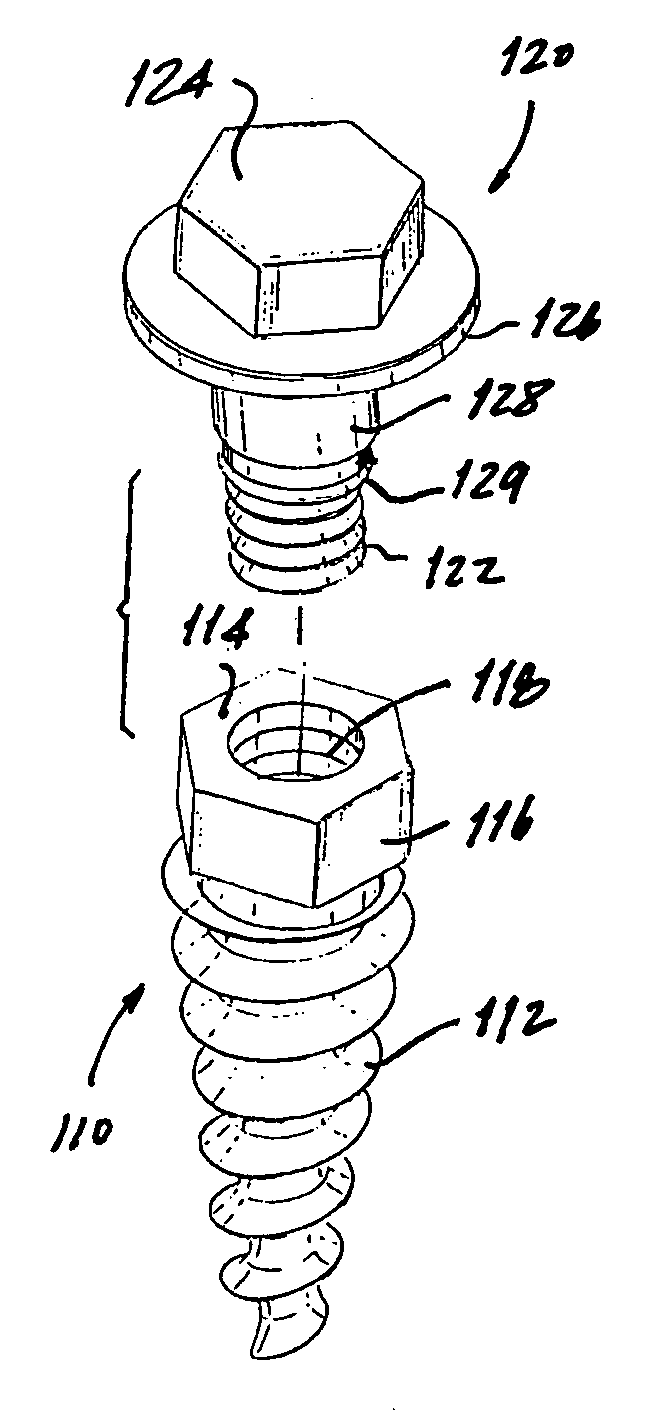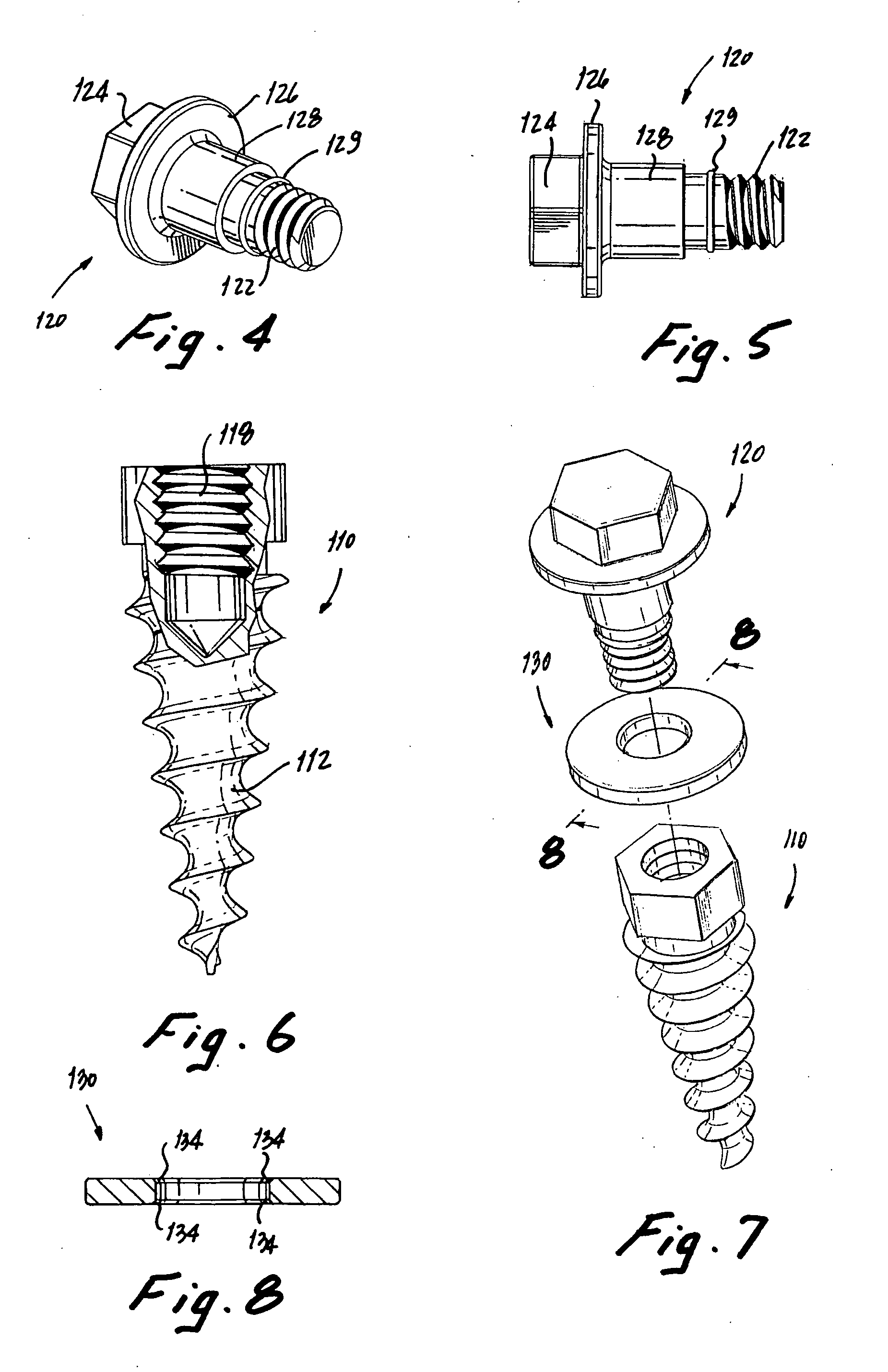It is a common problem for tendons and other soft, connective tissues to separate from associated bone, either through tearing of the tissue itself or detachment of the tissue from the bone.
One common example of this problem is the “
rotator cuff” tear, wherein the supraspinatus
tendon separates from the
humerus, causing pain and an inability to elevate and externally rotate the arm.
Due to the use of a large incision and the need to detach the deltoid
muscle, the classic open technique inflicts significant trauma on the deltoid and the surrounding tissues.
Further, the damage sustained by the deltoid necessitates postoperative deltoid protection, retarding
rehabilitation and potentially resulting in residual
weakness.
However, despite its associated advancements, the mini-open technique, like the classic open, involves a great deal of patient discomfort, mainly owing to the relatively large
skin incision and significant deltoid manipulation involved.
Further, the typical
recovery time of approximately four months to more than one year, while being reduced with respect to the classic open approach, is still quite lengthy.
While open surgical techniques represent the current
standard of care for rotator
cuff repair, the persistent problems that accompany these procedures have led to the development of
less invasive arthroscopic rotator
cuff repair techniques.
It should be noted that, unlike in
open surgery,
bone anchors are an essential component of arthroscopic rotator
cuff repair, as it is not feasible to form transosseous tunnels arthroscopically.
This
low frequency of use is due to two significant limitations of the arthroscopic procedures: the significant technical complexity involved in performing the procedure and the deficiencies in commonly available
bone anchors.
First, intracorporeal suturing of soft tissues while working through a trocar under endoscopic
visualization is clumsy and
time consuming, and allows only the simplest suture stitch patterns to be utilized.
Second, intracorporeal
knot tying, necessary to secure the sutures to bone, is exceptionally challenging.
Extracorporeal knot tying is somewhat less difficult, but the ultimate tightness of the knots is difficult to judge, and the tension cannot be adjusted later.
These technical difficulties surpass those experienced in performing
open surgery and contribute to the lack of use of arthroscopic rotator cuff repair.
Aside from the technical complexity involved with arthroscopic
surgery, commonly available
bone anchors have several inherent problems.
In practice, both features have proven problematic.
Given the necessarily small size of the eyelet, the loads experienced by the rotator cuff during normal shoulder use can result in high stresses in the eyelet, possibly leading to failure.
Eyelet failure is a commonly seen problem, and is a concern for virtually all bone anchors available today.
This securing method, while generally well-known, presents special challenges when used in bone.
Specifically, existing bone anchor screws tend to loosen over time, an exceptionally deleterious phenomenon in light of the fact that retightening, if at all possible, requires another surgical procedure.
However, as will be seen, many challenges still remain.
However, these anchors are more complicated to manufacture than the simple screw, and neither concept addresses the aforementioned problem of eyelet failure.
The Pierce approach, while successful in eliminating both the eyelet and the screw-like anchoring portion, has several drawbacks, including the inability to suture the
soft tissue prior to anchoring the suture to bone to allow approximating the
soft tissue to bone, and, the use of a relatively complicated structure.
The approach of the Bartlett patent, as with the Pierce patent, while innovative, is disadvantageous to the extent that it involves the use of a unique and complex
insertion tool that can be difficult to deploy.
It also does not permit approximating the soft tissue to bone at the conclusion of the suturing procedure.
Additionally, in preferred embodiments, the suture is knotted to the anchor, a known
disadvantage.
Finally, Bartlett requires the challenging step of knot tying to fix the tissue to the bone.
Consequently, there is no opportunity to optimally approximate the soft tissue to the bone upon completion of the surgical procedure.
Additionally, the approach is complex and limited in flexibility, since the suture is directly engaged with the bone anchoring body.
There is also the possibility that the bone anchoring body will not sufficiently rotate to firmly become engaged with the
cancellous bone before the
insertion tool breaks away from the anchor body, in which case it will be impossible to properly anchor the suture.
Finally, the problem of knot tying remains.
Of course, this
system has similar disadvantages to those of the Pedlick et al.
system.
However, none in any way address the problem of intracorporeal knot tying for
suture fixation.
Although the Golds et al. patent approach utilizes a wedge-shaped member to lock the sutures in place, the suture legs pass through the bore of the bead only one time, in a proximal to distal direction, and are locked by the collapsing of the wedge, which creates an interference on the longitudinal bore of the anchor member.
However, such a solution would make for an expensive combination of complicated parts, and would still be prone to all of the previously highlighted problems related to the bone anchors.
However, the construct shown is complicated, and does not appear adequate for reliably fixating the suture.
Further, its threaded anchoring portion is potentially vulnerable to loosening over time.
Further, the
system is disadvantageous in that it is complex and difficult to manipulate.
Although this approach eliminates the need for knots in the attachment of sutures to bone, it creates new obstacles to properly setting the tension in the sutures.
This action increases the tension in the sutures, and may cause garroting of the soft tissues or failure of the sutures.
In addition, the minimal surface area provided for gripping the sutures between the plug and the wall of the anchor portion will accelerate abrasion of the suture such that its ability to carry load will be greatly compromised.
Although the system provides what can be described as a simplified approach for fixating a suture to both a bone screw and
connective tissue, the device itself is complicated to use and expensive to manufacture.
However, even in cases where the procedure is successfully completed and the associated devices (e.g. bone anchor) perform reliably, problems can ensue due to failure of the tissue being sutured.
The preceding discussion has generally shown that the existing methods for suturing rotator cuffs and the bone anchors used in these procedures are not optimal.
However, these methods are not presently considered to be feasible for shoulder repair procedures, due to the possibility that these items could fall out and
cause injury during movement.
As such, physicians are reluctant to leave anything but a suture in the
capsule area of the shoulder, and when something other than a suture must be used, the attachment point often must be located at a less than ideal position.
Further, both tacks and staples require a substantial hole in the soft tissue, and make it difficult for the surgeon to precisely locate the soft tissue relative to the bone.
 Login to View More
Login to View More  Login to View More
Login to View More 


